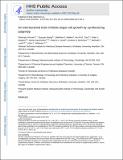An interbacterial toxin inhibits target cell growth by synthesizing (p)ppApp
Author(s)
Ahmad, Shehryar; Wang, Boyuan; Walker, Matthew D.; Tran, Hiu-Ki R.; Stogios, Peter J.; Savchenko, Alexei; Grant, Robert A; McArthur, Andrew G.; Laub, Michael T; Whitney, John C.; ... Show more Show less
DownloadAccepted version (4.422Mb)
Publisher Policy
Publisher Policy
Article is made available in accordance with the publisher's policy and may be subject to US copyright law. Please refer to the publisher's site for terms of use.
Terms of use
Metadata
Show full item recordAbstract
Bacteria have evolved sophisticated mechanisms to inhibit the growth of competitors1. One such mechanism involves type VI secretion systems, which bacteria can use to inject antibacterial toxins directly into neighbouring cells. Many of these toxins target the integrity of the cell envelope, but the full range of growth inhibitory mechanisms remains unknown2. Here we identify a type VI secretion effector, Tas1, in the opportunistic pathogen Pseudomonas aeruginosa. The crystal structure of Tas1 shows that it is similar to enzymes that synthesize (p)ppGpp, a broadly conserved signalling molecule in bacteria that modulates cell growth rate, particularly in response to nutritional stress3. However, Tas1 does not synthesize (p)ppGpp; instead, it pyrophosphorylates adenosine nucleotides to produce (p)ppApp at rates of nearly 180,000 molecules per minute. Consequently, the delivery of Tas1 into competitor cells drives rapid accumulation of (p)ppApp, depletion of ATP, and widespread dysregulation of essential metabolic pathways, thereby resulting in target cell death. Our findings reveal a previously undescribed mechanism for interbacterial antagonism and demonstrate a physiological role for the metabolite (p)ppApp in bacteria.
Date issued
2019-11Department
Massachusetts Institute of Technology. Department of BiologyJournal
Nature
Publisher
Springer Science and Business Media LLC
Citation
Ahmad, Shehryar et al. "An interbacterial toxin inhibits target cell growth by synthesizing (p)ppApp." Nature 575, 7784 (November 2019): 674–678 © 2019 The Author(s)
Version: Author's final manuscript
ISSN
0028-0836
1476-4687